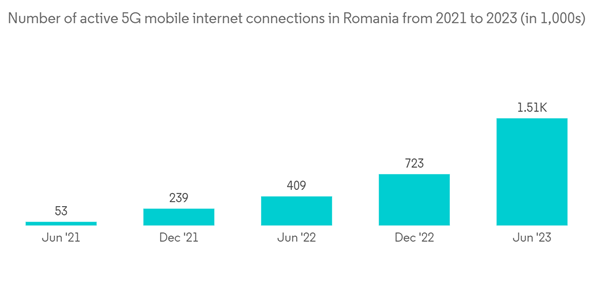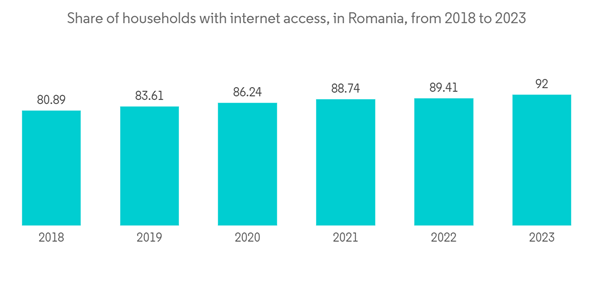The Romania Telecom Market size is estimated at USD 3.68 billion in 2024, and is expected to reach USD 3.93 billion by 2029, growing at a CAGR of 1.32% during the forecast period (2024-2029).
Key Highlights
- Romania has established a reliable telecommunication infrastructure encompassing many services, including fixed-line telephony, mobile networks, broadband internet, and data connectivity. The infrastructure is built upon extensive fiber-optic networks and high-speed internet connectivity, facilitating seamless data transmission, voice, and multimedia content.
- According to the International Trade Association, Romania holds the sixth position among the fastest-growing countries for fixed broadband and the 43rd position among the fastest countries for mobile Internet. Key market players are launching high-speed broadband services in line with the government's push to expand broadband coverage and enhance 4G and 5G networks.
- According to Ookla Speedtest Global Index, Romania ranked 12th with a median fixed broadband download speed of 211.66 Mbps in May this year. The demand for fixed broadband services is growing significantly, creating new growth opportunities for the telecom market.
- Romania leads the region with its advanced and competitive internet infrastructure. In August 2022, the country ranked 14th globally for its average fixed broadband speed, clocking in at an impressive 123.31 Mbps. This speed was more than double the global average of 69.14 Mbps, as reported by InvestRomania. This technological rise stems from the robust internet infrastructure. Its reinforcement lies in the hands of a constantly growing pool of talented developers.
- In recent years, Romania's telecom market has witnessed notable transformations. Vodafone’s acquisition of Liberty Global's UPC Romania bolstered Vodafone Romania's position, enhancing its ability to provide bundled services. Additionally, in a strategic move, Orange Romania purchased Telekom Romania's fixed-line assets from Deutsche Telekom's OTE. This acquisition directly responded to growing competition in the fixed-line arena, notably from Digi, pressuring Telekom Romania to ramp up its fixed-line infrastructure investments.
Romania Telecom Market Trends
The Demand for 5G Networks is Rising Across the Nation
- According to Eurostat, from 2017 to June 2023, Romania witnessed a notable decline in the market share of 2G and 3G mobile internet connections. In stark contrast, the adoption of 4G and 5G connections surged, jumping from 35.8% in 2017 to a dominant 74% by June 2023.
- The players in the market are taking steps to improve the availability and accessibility of 5G in Romania. In March 2023, Orange inaugurated its second 5G laboratory in Iași, Romania, focusing on automotive technology. This hub is designed for collaboration among academic institutions, start-ups, and companies in the Moldova region, facilitating the development and testing of 5G-based solutions.
- In November 2022, ANCOM held a widely covered 5G auction, allocating 420 MHz of spectrum across various bands: 700 MHz, 1500 MHz, 2600 MHz, and 3400-3800 MHz.
- The Romanian government is bolstering the nation's digital infrastructure through investments in digital frameworks. The Authority for the Digitisation of Romania, in partnership with the Technical University of Cluj-Napoca, developed a strategic roadmap spanning 2021-2027. A key objective of this plan is to lay the groundwork for a national AI strategy. These endeavors underscore the necessity of reliable 5G connectivity to successfully deploy emerging technologies such as AI.
The Demand for OTT and PayTV Services is Growing
- Romania's OTT and PayTV services are witnessing significant growth, propelled by rising internet penetration, the prevalence of smart devices, a robust ICT infrastructure, shifting consumer tastes, and the strong foothold of leading OTT players like Netflix and YouTube. This growth is further bolstered by the diverse content offerings on OTT platforms.
- The country is witnessing a rising internet penetration among households, which is further making it easier for individuals in Romania to access OTT and PayTV channels. In 2023, Romania saw a 2.6 percentage point rise in households with internet access, marking a 2.91% increase from the previous year. This surge brought the share of internet-connected households to a record high of 92%, the peak in the observed period. Impressively, this metric has shown a consistent upward trend in recent years.
- In August 2023, Romania's iNES Group unveiled its latest OTT platform, iNES Live. The platform is accessible through its dedicated website is designed to facilitate the national-level linear distribution of TV channels. Leveraging OTT technology, iNES Live harnesses subscribers' internet connections for content delivery. iNES Live boasts an impressive lineup featuring 100+ channels, with more than 90 available in HD and a select few in 4K. The platform is segmented into three distinct packages: iNES Live Basic, iNES Live Plus, and iNES Live Premium.
- The high penetration of 5G in the country has significantly boosted the availability of high-speed internet services. This, combined with technological advancements in smart devices such as mobiles, laptops, and TVs, has fueled the growth of OTT and PayTV services. Consequently, users can now conveniently access their favorite content online.
- Over the past few years, there has been a notable uptick in the country's appetite for personalized and localized content. In turn, OTT service providers are expanding their offerings, frequently teaming up with market counterparts to capitalize on this growing trend.
Romania Telecom Industry Overview
Romania's telecom market is semi-consolidated due to the ongoing partnerships and recent advancements in the market. Some major players in the market include Vodafone Romania, Nokia Corporation, and Orange Romania.
- June 2024: Orange finalized the merger between Orange Romania SA (ORO) and Orange Romania Communications SA (OROC), with ORO absorbing OROC. This consolidation positioned the newly formed entity to advance Orange's vision of leading as the top choice for fixed-mobile convergent services in Romania, catering to both residential and business clientele. Additionally, the merger is set to invigorate investment and foster heightened competition within Romania's telecommunications market.
- April 2024: DIGI Romania introduced SkyShowtime to its network, marking the streamer's inaugural B2B partnership in Central and Eastern Europe. As part of this collaboration, DIGI customers can access the complete SkyShowtime service through specially curated bundled offers, with further details set to be unveiled in the upcoming months.
Additional Benefits:
- The market estimate (ME) sheet in Excel format
- 3 months of analyst support
This product will be delivered within 2 business days.
Table of Contents
1 INTRODUCTION
4 MARKET INSIGHTS
5 MARKET DYNAMICS
6 MARKET SEGMENTATION
7 COMPETITIVE LANDSCAPE
Companies Mentioned (Partial List)
A selection of companies mentioned in this report includes, but is not limited to:
- Nokia Corporation
- Huawei Technologies Co. Ltd
- Telefonaktiebolaget LM Ericsson
- Vodafone Romaina
- Orange Romania
- Digi Communications NV
- Telus
- Telekom Romania Mobile
- Teleperformance SE
- Foundever
Methodology

LOADING...










